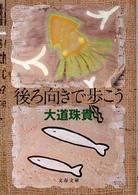- ホーム
- > 洋書
- > 英文書
- > Science / Mathematics
Full Description
A description of field-theoretical methods for the design and analysis of planar waveguide structures and antennas. The principles and limitations of transit-time devices with different injection mechanisms are covered, as are aspects of fabrication and characterization. The physical properties of silicon Schottky contacts and diodes are treated in a separate chapter, while two whole chapters are devoted to silicon/germanium devices. The integration of devices in monolithic circuits is explained together with advanced technologies, such as the self-mixing oscillator operation, before concluding with sensor and system applications.
Contents
1. Fundamentals.- 1.1 Silicon as the Base Material for MMICs.- 1.2 Linear Passive Planar Millimeter Wave Circuits on Silicon.- 1.2.1 Wave Propagation in Planar Structures.- 1.2.2 Planar Transmission Lines.- 1.2.3 Planar Transmission-Line Discontinuities.- 1.2.4 Planar Resonators.- 1.3 Planar Millimeter-Wave Antennas on Silicon.- 1.3.1 Antenna Elements.- 1.3.1 Antenna Arrays.- 1.4 Planar Millimeter-Wave Circuits Containing Active and Nonlinear Elements.- 1.5 Appendix: Closed-Form Expressions for Transmission-Line Characteristics.- References.- 2. Transit-Time Devices.- 2.1 Principles of Transit-Time-Induced Negative Resistance.- 2.2 Injection Mechanisms.- 2.2.1 Impact Ionisation - IMPATT Diode.- 2.2.2 Thermionic Emission - BARITT Diode.- 2.2.3 Tunnel Injection.- 2.2.4 The Misawa Mode.- 2.3 Numerical Large-Signal Simulations.- 2.4 Skin Effect.- 2.5 Thermal Properties.- 2.5.1 Integrated Transit-Time Devices.- 2.5.2 Diamond Heat Sinks.- 2.5.3 Ring Diodes.- 2.5.4 Transient Thermal Resistance.- 2.5.5 Measurement of the Thermal Resistance.- 2.6 Design Constraints.- 2.7 Technology.- 2.7.1 Material Growth.- 2.7.2 Contacts.- 2.7.3 Handling Techniques.- 2.7.4 Packaging.- 2.8 Performance.- 2.8.1 Power.- 2.8.2 Efficiency.- 2.8.3 Noise.- 2.9 New Transit-Time Device Concepts.- References.- 3. Schottky Contacts on Silicon.- 3.1 Schottky-Barrier Models.- 3.1.1 The Schottky Mott Model.- 3.1.2 The Space Charge Region.- 3.1.3 Bardeen's Model.- 3.1.4 Linear Models.- 3.1.5 Barrier Height Correlations.- 3.1.6 Advanced Models: Charge Transfer Across the Interface.- 3.2 Epitaxial Diodes on Si.- 3.2.1 Single-Crystalline Schottky Contacts.- 3.2.2 Other Orientational Dependences.- 3.2.3 CaSi2 and Ag.- 3.2.4 Polycrystalline Epitaxial Contacts on Si.- 3.2.5 Unconventional Metals with Small Lattice Mismatch to Si.- 3.2.6 Summary.- 3.3 Electrical Transport Properties.- 3.3.1 Emission Over the Barrier.- 3.3.2 Tunneling Through the Barrier.- 3.3.3 Generation Recombination in the Space Charge Region.- 3.3.4 Minority Carrier Injection.- 3.3.5 Inhomogeneities in Schottky Contacts.- 3.3.6 Noise Properties.- 3.3.7 Microwave Properties.- 3.4 Schottky-Barrier Measurements.- 3.4.1 Current-Voltage Curves.- 3.4.2 Capacitance Measurements.- 3.4.3 Internal Photoemission (Photoresponse).- 3.4.4 External Photoemission.- 3.4.5 Results for Polycrystalline Contacts.- 3.5 Conclusions.- References.- 4. SiGe Heterojunction Bipolar Transistors.- 4.1 Operation Principle of Homojunction and Heterojunction Bipolar Transistors.- 4.1.1 The Bipolar Junction Transistor and Its Physical Limits.- 4.1.2 The Heterojunction Bipolar Transistor.- 4.1.3 The Si/Ge Material System.- 4.2 Design of SiGe HBT Layers.- 4.2.1 Emitter Design.- 4.2.2 Base Design.- 4.2.3 Collector Design.- 4.3 Fabrication Technologies and Device Performance.- 4.4 Applications of SiGe HBTs.- 4.5 Conclusion.- References.- 5. Silicon Millimeter-Wave Integrated Circuits.- 5.1 Silicon as the Substrate Material.- 5.1.1 Silicon-Substrate Waveguide Parameters.- 5.1.2 Surface Waves.- 5.2 Millimeter-Wave Sources for SIMMWICs.- 5.2.1 IMPATT Oscillator.- 5.2.2 Varactor-Tuned Oscillator.- 5.2.3 HBT Oscillator.- 5.3 SIMMWIC Transmitter.- 5.3.1 Thermal Limitation of Monolithic IMPATT Diodes.- 5.3.2 Coplanar Slot-Line Transmitter.- 5.4 SIMMWIC Receiver.- 5.4.1 Microstrip Receiver.- 5.4.2 Coplanar Slot-Line Receiver.- 5.4.3 Resonant Tunneling Rectenna.- 5.5 SIMMWIC Switch.- References.- 6. Self-Mixing Oscillators.- 6.1 Principle of Operation.- 6.2 Linear Disturbance Theory.- 6.2.1 Model for the Self-mixing Oscillator.- 6.2.2 Conversion-Gain Factors.- 6.2.3 Simplified Device Model.- 6.3 Matrix Formulation of Conversion Gain.- 6.3.1 Conversion Matrix.- 6.3.2 Conversion Gain.- 6.4 Noise in Self-Mixing Oscillators.- 6.4.1 RF Noise.- 6.4.2 Low Frequency Noise.- 6.5 Numerical Simulations.- 6.6 Measuring Techniques and Experimental Results.- 6.6.1 Measuring Set-up.- 6.6.2 Experimental Results of a Si-IMPATT Device in the V-band.- References.- 7. Silicon Millimeter-Wave Integrated Circuit Technology.- 7.1 Technological Requirements for a Millimeter-Wave Substrate.- 7.1.1 Historical Background of SIMMWIC Technology.- 7.1.2 Characterization of High-Resistive Silicon Substrates.- 7.1.3 Behaviour of High-Resistive Silicon Substrates During Fabrication Processes.- 7.2 Basic Technologies.- 7.2.1 Buried Layers.- 7.2.2 Epitaxial Growth.- 7.2.3 Lithography.- 7.2.4 Pattern Transfer.- 7.2.5 Metallization and Air Bridge Technology.- 7.3 Fabrication Process and Monolithic Integration of Two-Terminal Devices.- 7.3.1 Fabrication Process of Coplanar Schottky-Barrier Diodes.- 7.3.2 Fabrication Process of Monolithically Integrated Transit-Time Diodes.- 7.3.3 Fabrication Process of Lateral PIN Diodes.- 7.4 Fabrication Process of Three-Terminal Devices.- 7.4.1 Bipolar Transistors.- 7.4.2 Hetero Bipolar Transistors for SIMMWICs.- 7.5 Summary and Prospects.- References.- 8. Future Devices.- 8.1 Physics and Applications of Si/SiGe, Double-Barrier Structures.- 8.1.1 Band Structure of Si/SiGe.- 8.1.2 Tunneling Current Calculation.- 8.1.3 The Quantum-Mechanical Concept of Electromagnetic Oscillations from Resonant-Tunneling Double Barriers.- 8.1.4 Calculation of fmax for n-type Si/SiGe Tunneling Diodes.- 8.1.5 Equivalent-Circuit Analysis of Oscillation Frequency and Output Power from an n-type Si/SiGe Double-Barrier Diode.- 8.1.6 Millimeter-Wave Detection by Si/SiGe Double Barriers.- 8.2 The Si/SiGe Quantum Barrier Varactor Diode.- 8.3 Field-Effect Devices: Si/SiGe MODFET and MOST, ?-Doped Si FET.- 8.3.1 dc and HF Modeling.- 8.3.2 Modeling Results and Comparison with Si n- and p-MOSTs.- 8.3.3 Experimental Results.- 8.3.4 Processing Steps: Growth and Post Processing.- Appendix 8.A The Effective-Mass Approximation.- Appendix 8.B Maximum Oscillation Frequency and Power Generation.- References.- 9. Future Applications.- 9.1 Sensor Applications.- 9.1.1 Measurement Principles.- 9.1.2 Radiometric Sensors.- 9.1.3 cw Radar Sensors.- 9.1.4 Frequency Modulated Radar Sensors.- 9.1.5 Pulse-Modulated Radars.- 9.2 Communication Applications.- 9.2.1 General Considerations.- 9.2.2 Identification Card Systems.- 9.2.3 Short-Range Data Transmission.- 9.2.4 Information Systems.- 9.2.5 Millimeter-Wave Data Bus.- 9.3 System Requirements.- 9.3.1 General System Aspects.- 9.3.2 Frequency Stability.- 9.3.3 Environmental Conditions.- 9.3.4 Packaging.- References.







